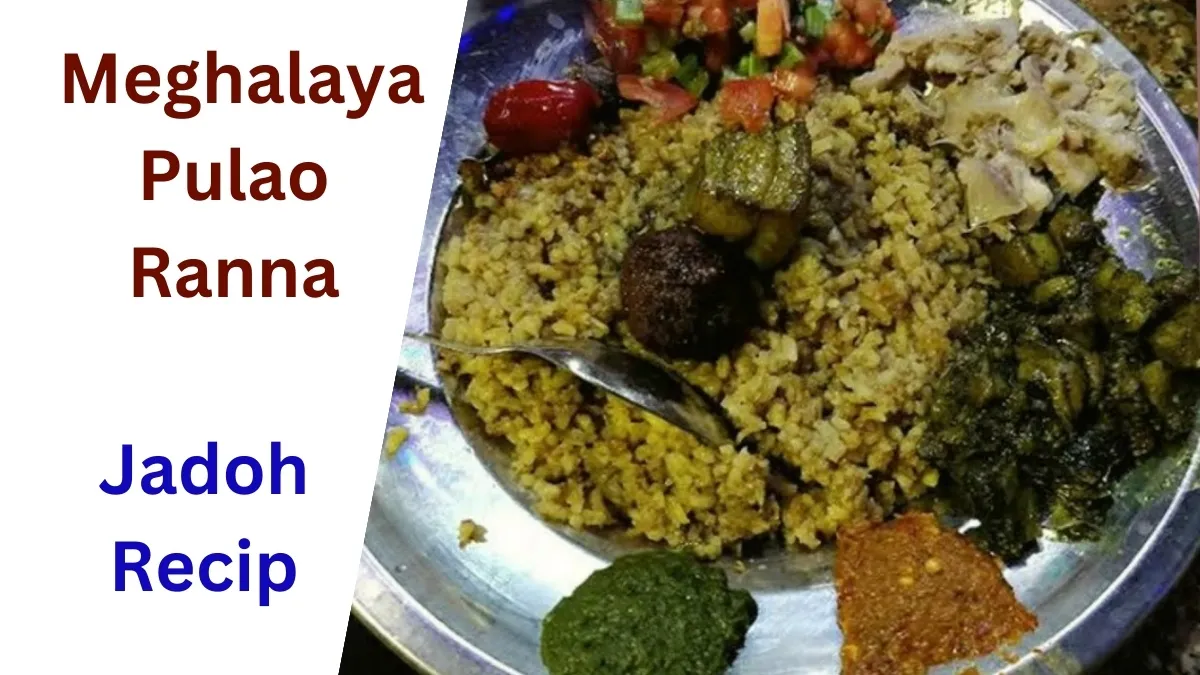Jadoh Recipe (Meghalaya Khasi Pulao Ranna)

Jadoh recipe is a traditional dish of Meghalaya, India, mainly cooked with basmati rice and khasi meat (many again use pork instead of khasi).
Jadoh Recipe (Meghalaya Khasi Pulao)
The recipe has maintained the cultural tradition of Meghalaya’s tribal communities to this day. As a result, its popularity has now spread worldwide, becoming a coveted recipe among food enthusiasts.

Comparison of Jadoh recipe with other Indian rice dishes
Rice dishes vary greatly across different regions of India, and among them, Jadoh stands out for its unique ingredients and preparation style, introducing a distinct flavor profile. Let’s look at other comparisons.
| Dish | Main Ingredients | Region |
| Jadoh | Rice, pork, turmeric, and spices | Meghalaya |
| Biryani | Rice, meat or vegetables, saffron, and aromatic spices | Pan India |
| Pulao | Rice, meat or vegetables, and a few selected spices | Pan India |
As an alternative to biryani, the Jadoh recipe is no less than a royal dish. Because this too is a heavily spiced food like biryani, not mild like pulao.
Ingredients
Let’s take a look at the essentials that make this dish truly special.
Key Elements Of Authentic Jadoh
At the core of Jadoh lies a set of key ingredients, vital for its unique taste:
- Rice – The foundation of Jadoh, preferably a flavorful local variety.
- Pork – Pork / Khasi meat – A generous portion of pork meat (Or, Khashi meat), marinated and cooked to tender perfection.
- Turmeric
- Ginger & Garlic
- Green Chillies – Chopped or slit, they add a gentle kick of heat.
- Black Sesame Seeds – These are gently roasted and ground, offering nutty undertones.
- Onions – Sliced onions caramelize and sweeten the dish, enhancing its complexity.
Variations Across Meghalaya
Jadoh sees delightful tweaks as you traverse Meghalaya. Each region imparts its local flair:
| Region | Variation Highlight |
| Khasi Hills | Jadoh cooked with pork blood for added richness |
| Jaintia Hills | A more aromatic version with bay leaves and spices |
| Garohills | Chicken or fish substituted for pork in Jadoh |
Whether steeped in tradition or adapted to local tastes, Jadoh’s essence remains in its blend of simple, yet profound ingredients.
Read also: Chirer Polao Recipe (Delicious Twist on Comfort Food).
Cooking Techniques
Traditional Preparation Steps
To truly honor the essence of Jadoh, one must delve into the time-honored techniques passed down through generations. These steps illustrate the tried and true method:
- Rinse the local red rice thoroughly to remove impurities.
- Marinate pork meat with turmeric and salt.
- Use a traditional pot to cook the rice with the meat.
- Slow-cook over firewood to infuse a smoky flavor.
- Blend in green chilies, black pepper, and other spices.
- Finish cooking until rice and meat are tender and flavors meld.
Adapting The Method For Modern Kitchens
While the original technique of preparing Jadoh is deeply entrenched in tradition, modern adaptations allow for seamless integration into contemporary cooking setups.
- Use a rice cooker or pressure cooker to save time.
- Substitute wood fire with a gas or electric stove.
- Opt for lean cuts of meat for a healthier version.
- Employ spice mixes to replicate the authentic taste.
- Taste test periodically to adjust spices as required.
Remember, adjusting the cooking method does not compromise the dish’s integrity but instead brings rich Khasi flavors to diverse kitchens around the world.
Nutritional Profile
Let’s know the calorie and nutritional content of Jadoh food –
Health Benefits Of Jadoh
- High in Protein: The meat in Jadoh is a rich source of protein, vital for muscle repair and growth.
- Loaded with Vitamins: The spices offer B vitamins and vitamin C, supporting energy levels and immunity.
- Rich in Minerals: Ingredients in Jadoh provide essential minerals such as iron and zinc.
Caloric And Nutritive Content Analysis
| Nutrient | Amount Per Serving |
| Calories | Approx. 350 kcal |
| Protein | 20 g |
| Carbohydrates | 45 g |
| Fat | 15 g |
| Fiber | 2 g |
| Vitamins and Minerals | Varies |
Serving And Pairing
Best Accompaniments With Jadoh
A savory plate of Jadoh invites a range of side dishes to complement its bold flavors. Here’s a list of the best accompaniments:
- Dohneiiong: A rich pork curry, simmering spices marry tender pork.
- Tungrymbai: Fermented soybean chutney adds a tangy twist.
- Pukhlein: Sweet rice cakes contrast Jadoh’s spiciness.
- Green Salad: Freshness to balance the hearty meal.
- Pickle: A burst of acidity cuts through the rich flavors.
Serving Suggestions For Special Occasions
Celebrate special moments with Jadoh served in a style befitting the occasion. Impress your guests with these suggestions:
- Use banana leaves as plates: infuse meals with aroma and tradition.
- Display the spread on wooden platters: enhance the rustic charm.
- Offer a traditional Khasi drink, kiat: to begin the feast.
- Decorate with local flowers: immerse in a festive atmosphere.
- End with a dessert: sweet rice pudding rounds off nicely.
Efforts To Keep The Tradition Alive
To preserve Jadoh’s authenticity, cultural groups organize cooking workshops. They teach the precise blend of spices that defines Jadoh’s unique flavor profile. Chefs and home cooks alike delve into the history as they cook.
- Cookbooks include Jadoh recipes, ensuring knowledge transfer.
- Local communities strive to pass the recipe to new generations.
How To Make Khasi Jadoh?
Brief instructions: Begin by soaking rice and set aside. Cook pork and turmeric in oil until browned. Add ginger, garlic, onions, and stir. Pour in the rice, season with salt, and mix. Cook with the requisite water until the rice is done. Serve your Khasi Jadoh hot recipe.
You can read: Narthangai Pickle Recipe (Zesty Delight).
Try preparing the Jadoh recipe today and celebrate a rich culinary tradition with family, and friends.



